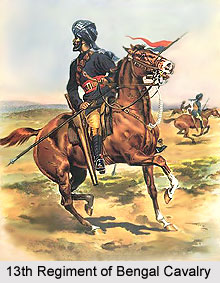 The 13th Regiment of Bengal Cavalry was a cavalry regiment of the British Indian Army. The regiment remained in existence from the year 1857 to 1921, after which it was united with the regiment of 16th Regiment of Bengal Cavalry to form the 6th Duke of Connaught`s Own Lancers (Watson`s Horse) unit. The 13th Regiment of Bengal Cavalry was a part of the Bengal Army, which was the armed forces of Bengal Presidency and was amongst the 3 main Presidency Armies in British India. The British Presidency Armies belonged to the British East India Company until the Sepoy Mutiny of 1857. In the year 1903, the 3 separate presidency armies were united to form the combined British Indian Army. The 13th Regiment of Bengal Cavalry was also known as the 4th Sikh Irregular Cavalry and also as the 13th Duke of Connaught`s Own Lancers (Watson`s Horse) regiment. The Duke of Connaught acted as the Colonel-in-Chief of the battalion.
The 13th Regiment of Bengal Cavalry was a cavalry regiment of the British Indian Army. The regiment remained in existence from the year 1857 to 1921, after which it was united with the regiment of 16th Regiment of Bengal Cavalry to form the 6th Duke of Connaught`s Own Lancers (Watson`s Horse) unit. The 13th Regiment of Bengal Cavalry was a part of the Bengal Army, which was the armed forces of Bengal Presidency and was amongst the 3 main Presidency Armies in British India. The British Presidency Armies belonged to the British East India Company until the Sepoy Mutiny of 1857. In the year 1903, the 3 separate presidency armies were united to form the combined British Indian Army. The 13th Regiment of Bengal Cavalry was also known as the 4th Sikh Irregular Cavalry and also as the 13th Duke of Connaught`s Own Lancers (Watson`s Horse) regiment. The Duke of Connaught acted as the Colonel-in-Chief of the battalion.
History of 13th Regiment of Bengal Cavalry
The 13th Regiment of Bengal Cavalry was formed at Lahore by Lieutenant John Watson and Lieutenant H Cattley at Lahore as the 4th Sikh Irregular Cavalry regiment in the year 1857, during the Great Revolt. Lieutenant Watson initially acted as the commanding officer of the regiment and held the post for the next eleven years. He initiated many changes in the riding patterns of the cavalry. The army unit took part in the Second Afghan War from the year 1878 to 1880. Later they served in Egypt and fought at the Battle of Tel-el-Kebir against Arabi Pasha in 1882
In the year 1897, the 13th Duke of Connaught`s Own Lancers (Watson`s Horse) regiment was involved in repressing the tribal revolts on the North West Frontier. During World War I, the military unit remained on the North West Frontier till July 1916, after which the battalion was stationed at Mesopotamia for the relief of Kut-al-Amara. Later the 13th Regiment of Bengal Cavalry provided service in Waziristan in the year 1919, during the Third Afghan War.
After the end of World War I, the British Indian army decided to decrease the number of cavalry regiments from 39 to 21. Instead of just disbanding the surplus regiments, the various military units were merged together in pairs. As a result the whole cavalry line was re-designated and renumbered. The 13th Regiment of Bengal Cavalry was amalgamated with the 16th Regiment of Bengal Cavalry (Rohilcund Horse) regiment on 1 June 1921 at Meerut. Both the units were unified to form the 13th/16th Cavalry, which later came to be known as the 6th Duke of Connaught`s Own Lancers (Watson`s Horse). This regiment was renamed as the 6 Lancers in 1956. The official uniform of this army unit was blue with scarlet facings and the badge included crossed lances with the number `6` on the point of intersection and a scroll below, showing `The Duke of Connaught`s Own`. The class composition of the 6 Lancers regiment was one squadron each of Dogras, Sikhs and Punjabi Muslims.
Designations of 13th Regiment of Bengal Cavalry
The 13th Regiment of Bengal Cavalry was designated a various times in the many re-organisations and restructuring in the British Indian Army. These are listed as follows-
* 4th Sikh Irregular Cavalry -1857
* 13th Regiment of Bengal Cavalry -1861
* 13th Regiment of Bengal Cavalry (Lancers) - 1864
* 13th Regiment of Bengal Lancers - 1874
* 13th (Duke of Connaught`s) Regiment of Bengal Lancers - 1884
* 13th (Duke of Connaught`s) Bengal Lancers - 1901
* 13th Duke of Connaught`s Lancers - 1903
* 13th Duke of Connaught`s Own Lancers Watson`s Horse -1904
* 6th Duke of Connaught`s Own Lancers Watson`s Horse (with 16th Cavalry) - 1921



















